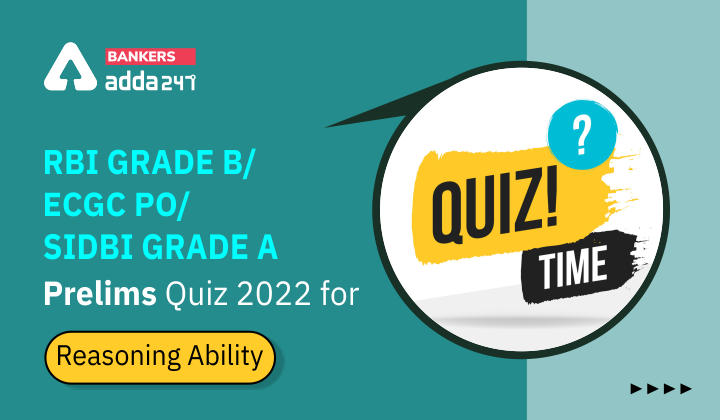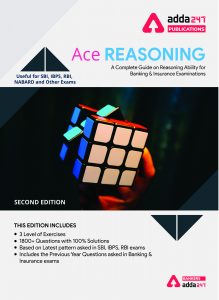Directions (1-5): Study the following information carefully and answer the given questions.
Eight persons are sitting around a circular table, in such a way some are facing inside while some are facing outside the center. Each of them likes different fruits. C sits third to the left of the one who likes Grapes. The one who likes Grapes faces outside. Only two persons sit between C and H. The one who likes Mango sits on the immediate right of H who is facing outside. The one who likes Kiwi sits second to the right of G. B likes Guava. G is neither an immediate neighbour of H nor of C. G does not like Grapes. Only one person sits between A and the one who likes Kiwi. D sits on the immediate left of the one who likes Banana. G does not like Banana. E likes Litchi. E is not an immediate neighbour of A who likes mango. The one who likes Apple is an immediate neighbour of E. The one who likes Orange is an immediate neighbour of F. B is facing same direction as F and E but opposite to A and C who does not like apple. C is facing same direction as D.
Q1. Who among the following likes Grapes?
(a) D
(b) E
(c) B
(d) F
(e) None of these
Q2. Who among the following sits second to the right of the one who likes Kiwi?
(a) B
(b) D
(c) G
(d) A
(e) None of these
Q3. A likes which of the following Fruit?
(a) Kiwi
(b) Mango
(c) Apple
(d) Orange
(e) None of these
Q4. Who among the following faces the one who sits third to the left of B?
(a) H
(b) the one who likes Orange
(c) E
(d) the one who sits second to the right of G
(e) None of these
Q5. Which of the following fruit likes by the one who sits third to the right of D?
(a) Apple
(b) Litchi
(c) Guava
(d) Banana
(e) None of these
Directions (6-10): Study the following information and answer the given questions:
In a certain code language
‘change article enough popular choice’ is written as “to ga di ba ni”
‘choice article culture change great’ is written as “ux to ni di xm”
‘reader popular change’ is written as “ga ni mo”.
‘article culture great life’ is written as ‘ux xm fa to’.
Q6. What does the code ‘ga’ stand for in the given code language?
(a) popular
(b) choice
(c) enough
(d) article
(e) None of these
Q7. What is the code for ‘life’ in the given code language?
(a) to
(b) fa
(c) xm
(d) ux
(e) None of these
Q8. What is the code “fa mo ba” stand for in the given code language?
(a) reader enough life
(b) great enough life
(c) reader enough change
(d) reader life popular
(e) None of these
Q9. What may the code ‘ux mo di’ stand for in the given code language?
(a) culture great choice
(b) reader popular choice
(c) reader culture life
(d) reader culture choice
(e) life article reader
Q10. What is the code for ‘change’ in the given code language?
(a) ba
(b) di
(c) ni
(d) ga
(e) None of these
Directions (11-15): In these questions, a relationship between different elements is shown in the statements. The statements are followed by two conclusions. Give answer
Q11. Statement: H<B; H≥D>E; G≥F>B
Conclusion: I. E≥B II. F≥H
(a) if either conclusion I or II is true.
(b) if only conclusion I is true.
(c) if neither conclusion I nor II is true.
(d) if only conclusion II is true.
(e) if both conclusions I and II are true.
Q12. Statement: K<J; D≤S=J; I>S; H≥J
Conclusion: I. I>H II. H≥I
(a) if both conclusion I and II are true.
(b) if neither conclusion I nor II is true.
(c) if only conclusion I is true.
(d) if either conclusion I or II is true.
(e) if only conclusion II is true.
Q13. Statement: J<L; K≥S; K≥O; S>L≥T
Conclusion: I. L>O II. O>T
(a) if only conclusion II is true.
(b) if either conclusion I or II is true.
(c) if neither conclusion I nor II is true.
(d) if only conclusion I is true.
(e) if both conclusions I and II are true.
Q14. Statement: T>N; A>S>Q; A<N
Conclusion: I.T>Q II. T>S
(a) if only conclusion II is true.
(b) if only conclusion I is true.
(c) if neither conclusion I nor II is true.
(d) if either conclusion I or II is true.
(e) if both conclusions I and II are true.
Q15. Statement: B≤C; B≤D; C=N; D<S
Conclusion: I. S≤C II. N≥S
(a) if only conclusion II is true.
(b) if either conclusion I or II is true.
(c) if neither conclusion I nor II is true.
(d) if only conclusion I is true.
(e) if both conclusions I and II are true.
Solutions






 GA Capsule for SBI Clerk Mains 2025, Dow...
GA Capsule for SBI Clerk Mains 2025, Dow...
 The Hindu Review October 2022: Download ...
The Hindu Review October 2022: Download ...
 NICL AO Admit Card 2025 Out, Direct Link...
NICL AO Admit Card 2025 Out, Direct Link...


